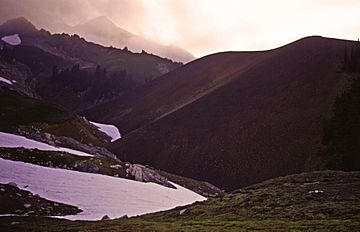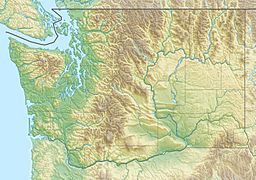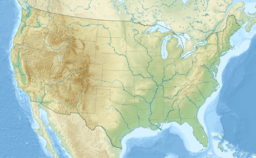White Chuck Cinder Cone facts for kids
Quick facts for kids White Chuck Cinder Cone |
|
|---|---|
 |
|
| Highest point | |
| Elevation | 6,020 ft (1,835 m) |
| Isolation | 0.64 mi (1.03 km) |
| Parent peak | Portal Peak (6,999 ft) |
| Geography | |
| Country | United States |
| State | Washington |
| County | Snohomish |
| Parent range | Cascade Range |
| Protected area | Glacier Peak Wilderness |
| Topo map | USGS Glacier Peak West |
| Geology | |
| Mountain type | Cinder cone |
The White Chuck Cinder Cone is a special type of volcano found near Glacier Peak in Snohomish County, Washington, USA. It sits close to where the White Chuck River begins. A person named Everett Houghland first reported seeing it in 1934.
This cinder cone stands about 6,020 feet (1,835 meters) tall. Scientists believe it is quite old, likely between 2,000 and 17,000 years old. They figured this out by looking at how much glaciers have worn it down over time.
Contents
What is a Cinder Cone?
A cinder cone is a simple, cone-shaped volcano. It is built from bits of hardened lava, called cinders, that erupt from a single vent. When these cinders fall back to the ground, they pile up around the vent, creating the cone shape. They are usually smaller than other types of volcanoes.
How White Chuck Cinder Cone Formed
The area where White Chuck Cinder Cone is located, known as the North Cascades, has very rugged land. You can see sharp peaks, tall ridges, and deep valleys carved by glaciers. These amazing landscapes were created by powerful geological events that happened millions of years ago.
Ancient Earth and Volcanoes
The story of the Cascade Mountains began millions of years ago, during a time called the late Eocene Epoch. This was when huge pieces of the Earth's crust, called tectonic plates, were moving. The North American Plate was slowly sliding over the Pacific Plate. This movement caused a lot of volcanic activity, leading to the formation of many volcanoes.
Glacier Peak, a much larger volcano called a stratovolcano, started to form even later. It is about 4.35 miles (7 kilometers) north-northeast of White Chuck Cinder Cone. Glacier Peak began its formation during the mid-Pleistocene period, which was over two million years ago. A stratovolcano is a tall, cone-shaped volcano built from many layers of hardened lava, ash, and rock.
The Power of Glaciers
During the Pleistocene period, which lasted for more than two million years, huge sheets of ice called glaciers repeatedly moved across the land. As these glaciers advanced and then melted back, they scraped and shaped the landscape. They left behind piles of rock and debris. The U-shaped valleys you see in the rivers today are a clear sign of this ancient glacial activity.
Over time, the land also experienced uplift (when the Earth's crust pushes upwards) and faulting (when cracks form in the Earth's crust and sections move). These forces, combined with the work of glaciers, created the tall peaks and deep valleys that make the North Cascades so dramatic.
Weather Around White Chuck Cinder Cone
White Chuck Cinder Cone is in a part of western North America that has a marine west coast climate. This means the weather is often influenced by the nearby Pacific Ocean.
Pacific Ocean's Influence
Most of the weather systems, called weather fronts, start over the Pacific Ocean. They usually travel northeast towards the Cascade Mountains. When these fronts hit the tall peaks of the Cascade Range, the air is forced to rise. This process is called orographic lift. As the air rises, it cools down, and the moisture in it turns into rain or snow, which then falls onto the Cascades.
Winter Snow and Summer Sun
Because of this, the western side of the North Cascades gets a lot of rain and snow, especially in winter. The snow here tends to be wet and heavy due to the ocean's influence. This can sometimes lead to a high risk of avalanches, which are sudden slides of snow down a mountain.
In winter, the weather is often cloudy. However, during the summer months, high-pressure systems over the Pacific Ocean become stronger. This often brings clear skies and lots of sunshine. Thanks to the mild climate and closeness to the Pacific Ocean, temperatures west of the Cascade mountains rarely drop below 0°F (-18°C) or rise above 80°F (27°C).
Gallery
See also
 In Spanish: Cono cinerítico White Chuck para niños
In Spanish: Cono cinerítico White Chuck para niños





